Similar Posts
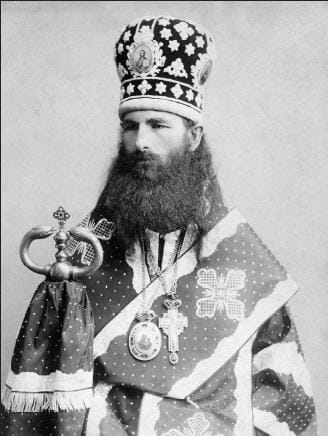
Bishop Vladimir Sokolovsky with his bishop’s staff.
One of the most surprising images one is faced with considering Orthodox liturgical symbolism is the bishop’s staff sporting two snakes flanking a small cross atop it. Especially in a Protestant North American context, this image seems to hark back to ancient chthonian cults, more a wizard’s magic staff than anything Christian. As I have been doing for other subjects, I would like to take a trip through iconography, through the Bible and other traditions to show how this symbol is all at once thoughtful, powerful and perfectly orthodox in the broadest sense. It also happens to fit nicely with all I have been writing for the OAJ up till now.
The first hurdle we must overcome is the perception that the Western bishop’s staff, the crosier, is really a shepherd’s staff, whereas the Orthodox have this strange snake bearing object. In fact, for a millennia at least, the western crosier was also identified with a serpent as medieval crosiers attest. We could say that there are two basic shapes, the crosier and the “tau” shaped staff which were present in the Church before the Schism, both of these shapes have been interpreted with serpents. The current Orthodox version of the staff with serpents (as seen above with Bishop Vladimir Sokolovsky) is a variation of these models.
We wonder though, how can such an image of serpents, both in the East and West be appropriate for the very symbol of a Bishop’s authority? Many will point to the Biblical story of the bronze serpent, somehow prefiguring Christ, as the basis for this use of serpents on the bishop’s staff. This is a perfectly sound explanation, though it is insufficient to create a complete picture. If we are to look a Moses as the origin of this image, we should look earlier. The very first time we encounter a staff in the Bible, at least a staff that is related to divine authority, is at the burning bush. When Moses doubts the Pharaoh will listen to him, God tells him:
“What is that in your hand?” He said, “A rod.” And He said, “Cast it on the ground.” So he cast it on the ground, and it became a serpent; and Moses fled from it. 4 Then the Lord said to Moses, “Reach out your hand and take it by the tail” (and he reached out his hand and caught it, and it became a rod in his hand), Exodus 4: 1-3
The very first time we encounter a staff of divine authority, it is immediately linked to a serpent. Here we find a first example of the “shiftiness” of the snake symbol, of its dual nature. In the story of Moses and pharaoh there are two origins of the serpents. We know that Pharaoh’s magicians could produce the same miracle, and so both sides make serpents from staffs, a “good” serpent and a “bad” serpent. The good one eats the bad one.
The shiftiness, the double sided aspect of the serpent symbol appears also in the story of the bronze serpent on several levels. The Israelites had been plagued by serpents, and to save them from the poisonous bites, God told Moses to make a bronze serpent and to put it on a staff. Whoever would look to the bronze serpent would be healed, yet those refusing to do so would die of their snake bite. In terms of duality, we can see clearly here how the serpent is both the disease and cure. Looking to the serpent that was “raised up” will cure one from those serpents that bite “down below”, just as an antidote is made from the poison or a vaccine is made from the disease. Another way to see the duality in the story is how this serpent that was raised up as a healing device, will later be “cast down” by the virtous king Hezekiah for having become an idol (2 Kings 18:4).
With the bronze serpent we understand the serpent is not only related to a staff, but also more generally to the “vertical”, the pole, the ladder, the axis. The staff is only one facet of this vertical symbol. The first and primal version of this symbol is of course the tree. So we must reach further back than Moses in the Biblical text, looking to one of the very first mentions of a specific tree: the Tree of Knowledge of Good and Evil in the middle of the garden. With this tree we find the serpent, and in Christian iconography, it has been represented unanimously as coiled around the Tree of knowledge as it entices Adam and Eve to eat from its fruit.
Icon of Adam and Eve. This is taken from the wonderful blog on icons: A Reader’s Guide to Orthodox Icons
We have spoken elsewhere of Death and the garments of skins (here and here), of death as the movement to the periphery, and with the snake wrapped around the tree, it is precisely what we get: death, animalism, skin, basically a series of wheels wrapped around a central axis. The serpent is the image of death, not a kind of extinction, but rather the living death of the Fall, the waxing and waning cycles of birth and death, of pleasure and pain, the life in duality. St-Gregory of Nyssa, the master of symbolism ties some of these images together speaking of men becoming « animals turning the mill. » « With our eyes blindfolded we walk round the mill of life, always treading the same circular path and returning to the same things …we never cease to go round in a circle. »[1].
Just as in the references from the book of Exodus, this primordial image of the serpent in Genesis also shows the general duality of the serpent symbol, for although it is right to say the serpent brought about a great evil, it is better to acknowledge the serpent brought about both good and evil, causing us to experience God as mercy and rigor and all the other manifestations of what we have called right and left hand symbolism in earlier posts (here, here and here).
Having gone from the staff back to the tree, it is difficult not to make the great leap forward which brings us to the foot of Cross. The relationship between the Tree, the staff of Moses or Aaron and the Cross is one I am not inventing. In apocryphal sources, the story of this relationship can be found everywhere from the Golden Legend in the West to the Eastern edge of traditional Christianity, in the Book of the Bee of Syriac Christians. These traditions take different forms, but their essential core is the same, that is how the staff of Moses is made from the tree of Knowledge[2], and the wood from this staff was somehow used to make the cross. The fantastical details in these stories need not keep us, for these traditions should be taken as “pointers” more than anything else, that is as ways to experience more clearly in Biblical tradition what is already there.
When considering these traditions, especially knowing they already participate in the iconography of the crucifixion[3], it cannot but shed a different light on the image. It becomes difficult not to notice the “S” shape of Christ’s body and how it invokes serpent symbolism. Christ compares himself to the bronze serpent saying, “And as Moses lifted up the serpent in the wilderness, even so must the Son of Man be lifted up,” (John 3:13-15) and in medieval images it was not rare to see crucifixion images with the snake on the lower tier and Christ on the top tier, both hanging on the same cross/tree of knowledge.
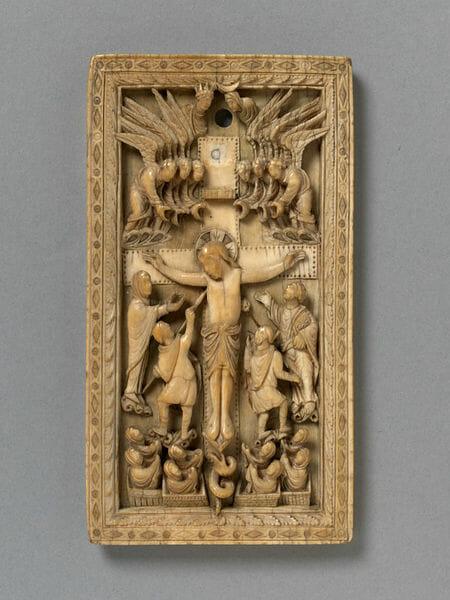
The serpent is at the center of the resurrecting dead on the axis of the cross. Crucifixion from the V&A Museum. Rheims, France (probably, made)
Date:ca. 860-870
This might come as a shock to some, but hopefully a few remarks will calm any controversy. We are used to see the snake as an image of the Evil One, and this is not a false attribution, but symbols are always multiple in depth of meaning. Considering the fullness of the symbol, that is when we look at Moses changing his staff to a serpent or the bronze serpent, limiting the image of a serpent to the Evil One creates some serious problems. Rather, we must look at the serpent more closely within the biblical stories themselves, and see there the power of death, death in the sense we have been expounding: as the periphery, the duality, the cycle, the garments of skin[4]. And this makes more sense within Orthodox teaching of Christ trampling down death by death, of the God-Man uniting himself to death in order to conquer death. In that light it is not surprising to see Christ taking a shape suggesting the serpent on the cross.
For those who still doubt this attribution of the snake to death, we need only consider the other great use of the serpent in iconography, that is the Serpent of Tribulation. In latter images of the Last Judgement, there appears a great serpent which slithers from the upper part of the icon, under Christ, sometimes starting at the foot of Adam, and swerving down to Hell. The human person on his or her death is meant to move along this serpent, and like nodes or knots in the serpent’s body appear the controversial tollhouses. I do not want to engage a discussion on tollhouses here. I only want to show how this use of the serpent is in line with our other interpretations. The movement on the serpent is not just one of moving down to Hell as some have said, but the soul of the deceased is shown both ascending and/or descending. Each station appears, like the bars in Jacob’s ladder, simultaneously as a step going up or coming down. Each sin is balanced by a virtue, each tollhouse contains both possibilities. A powerful quote relating to this from the Ladder of Divine Ascent is when St-John explains that in our spiritual journey “« …the original fervor can only enter by the door it had taken to exit. [5]”
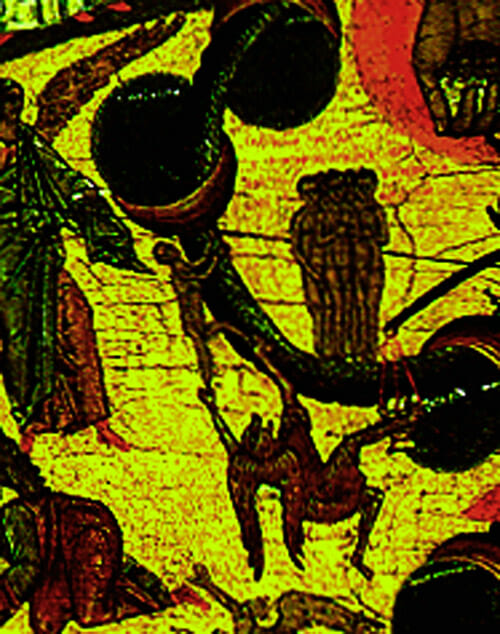
Detail of the Serpent of Tribulation. A soul attempting to ascend along the tollhouses is pulled down by a demon.
Having grounded the serpent in the Bible, iconography and other Orthodox traditions, we should not be afraid to look at and discuss analogous pagan images, for in this case we have much to ponder. The serpent on a pole is of course one of the oldest symbols we know of, it appears in its single and double versions everywhere from Sumer to Babylon, from the Greeks to the Aztecs. Much of the specific meanings of these lost cultures have disappeared with them, but at least from the Greeks we can gather a few interesting tidbits that will feed into the general meaning. In Greek myth, the serpent on a pole is associated with Asclepius (and to Hermes in its double aspect[6]).
The symbolism of the rod of Asclepius is so close to the bronze serpent that I remember as a child growing up in a Christian home thinking the symbol used by various medical groups was in fact the bronze serpent. Asclepius made his “medicine” from the blood of the Gorgon, one of the snake-related monsters of Antiquity. He would use blood from the right side of the beast to make his cures, suggesting that the left side of the beast was poisonous. Here again we have the dual nature of the snake, of the snake as both the cause and the cure for illness. Continuing along asclepian line in Greek thinking, we should ponder of course the word “pharmakon”, a word extensively used in this context. It is the greek word for “cure” in the medical sense while simultaneously being the word for “poison” or even a “drug” in the sense of “illegal drug” as it is used today. In English, the word “drug” does still contain all these meanings simultaneously. How can a word mean two opposing things at once? In a broader sense, the “pharmakon” is what is added to a nature, a supplement in order to enhance it, but which is also the very cause of its lacking. This addresses once again the nature of the supplement, of the garments of skin as both death and a protection from death. One of the most important words related to “pharmakon” is “pharmakos”, that is the “sacrificial victim”. It was the word used to describe the animal killedin the public sacrifices. In Greek thinking the pharmakos acts as pharmakon, that is, through sacrifice the cycle begins anew. We can see how this relationship finds its ultimate accomplishment in the cross, for if the incarnation of Christ seen at its extreme in the crucifixion is the finality of the garment of skins, if it contains in its unity the duality of the pharmakon, of the left and the right hand, it is because these are brought together in the final pharmakos, the pharmakos that is both God and sacrifice, the perfect and total sacrificial victim. I know the Orthodox approach avoids going too far in this theological direction, yet we should not completely discard it. Christ on the Cross unites heaven and earth by the vertical and gathers all horizontal opposites, heals the duality born in the fruit of the tree of knowledge by uniting the duality of the pharmakon in the God-pharmakos. All is made One in Christ. And in making all things one, duality and multiplicity are not abolished, rather they are seen as finding their root in him, as flowing from his person.
This last statement is a fitting point to return to our main subject. Duality, multiplicity, periphery do not need be an image of death. They only become an image of death when they “forget” their anchor, when the tree of Knowledge is viewed as being separate from the Tree of Life. And this is really the meaning of the bishop’s staff, of his crosier. It is the power of heaven on earth, the power of the keys, the power to bind and unbind, to bring in the sheep and push away the wolves, to bless and to curse. It is duality as expression of unity, periphery as expression of center. And so whether there are two serpents or one, whether a “Tau” or a crosier, the meaning is the same.
[1] Gregory of Nyssa quoted by Nellas in Deification in Christ, 87
[2] In some Traditions it is the tree of life and not the tree of Knowledge. In the Golden Legend for example both traditions are mentioned side by side. In the Book of Bee, I think we can see a hint to understanding this conundrum. In this version, the tree of knowledge/staff of Moses is used to make the “transversal” of the cross, the “horizontal” where Christ’s left and right hands are crucified. The tree of Life in this case, could be seen as the “vertical” aspect of the cross, the “bridge” between heaven and earth, and the Tree of Knowledge showing the cross as a “balance” in the manner we have shown earlier.
[3]The idea of Adam’s skull buried at Calvary is part of these cycles of traditions.
[4] In the Genesis story, the relation to death is obvious, so too in the story of the Bronze serpent. And although it appears less clearly at first glance, in the story of the staff of Moses we see the same. For the final result of the process begun with the staff becoming a snake is the coming of the Angel of Death on the land of Egypt. This both casts down the Egyptians and frees the Israelites, just as it is the death of Christ that lifted the “good thief” and brought down the “bad thief”.
[5], 1st degree, paragraph 25
[6] In the case of Hermes, there are a few things worth saying. Hermes is the messenger and the trickster. In this sense he is a “bridge” between worlds, he moves back and forth and in doing so he also has with him the power of inversion which is the root of trickery. This is in my opinion the main reason for the caduceus. Seeing the caduceus in this light can help us to understand a bit more how the death of Christ on the cross, his hanging on the tree is almost a mirror image of what happened in the Garden. It is indeed presented as a trick in many liturgical texts. Christ tricks the devil and hades by changing death into life, a reversion of what had been inverted at the beginning with the serpent.

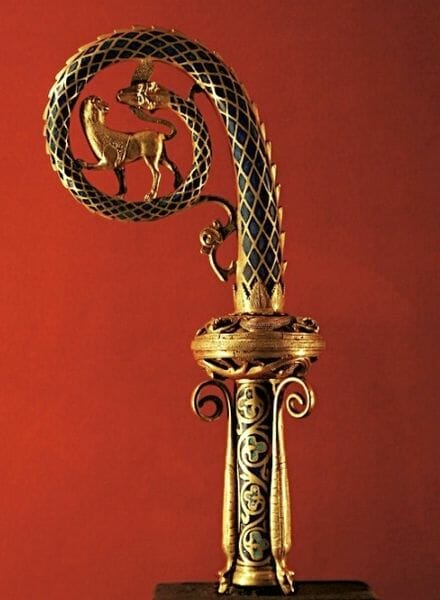
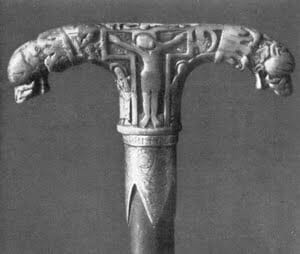
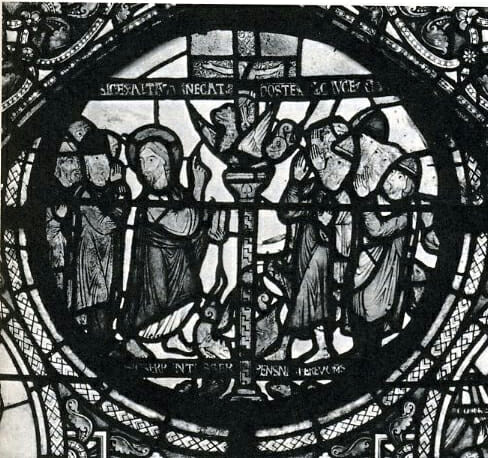
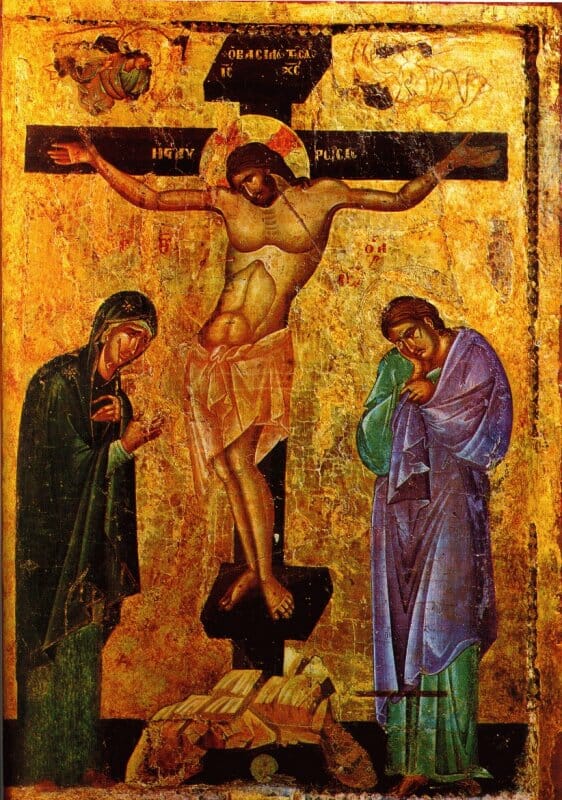
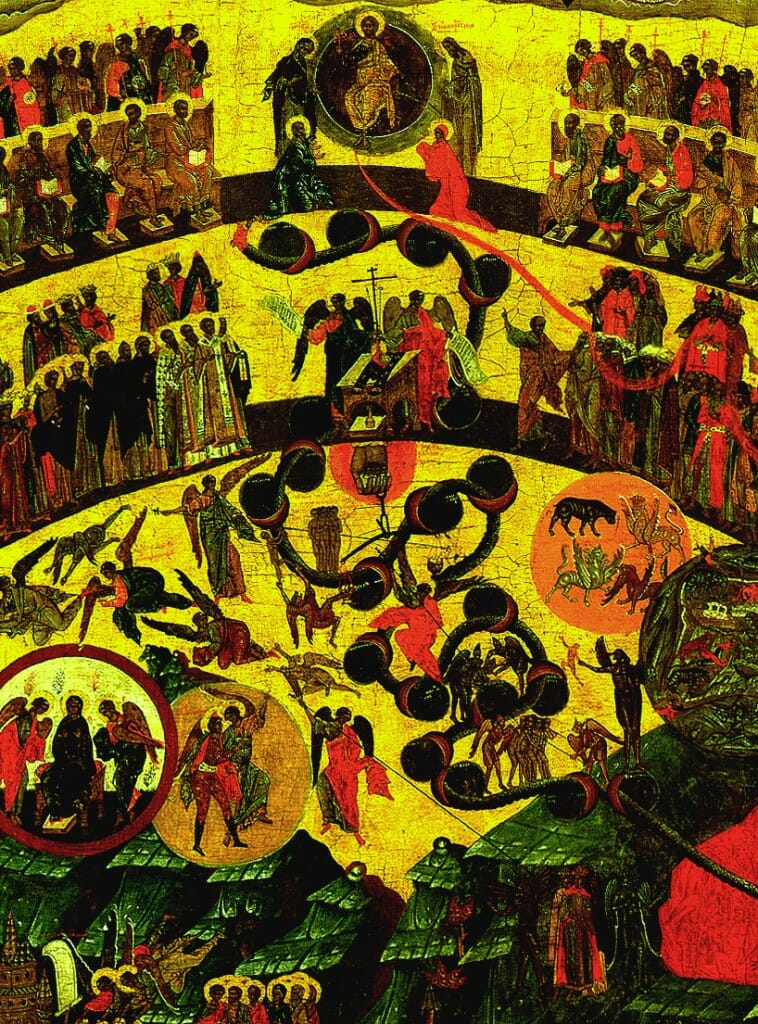
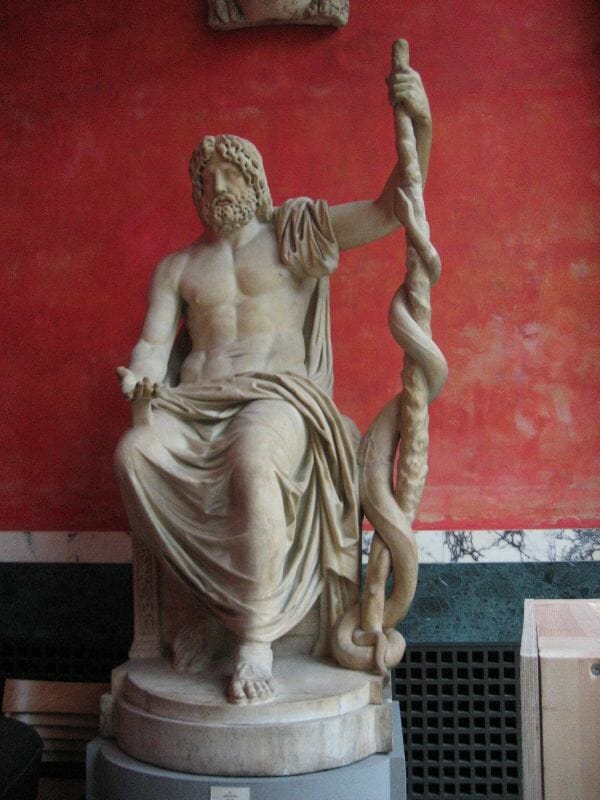
[…] https://orthodoxartsjournal.org/the-serpents-of-orthodoxy/Thursday, Apr 18th 7:32 amclick to expand… […]
Thank you, Jonathan.
It is necessary that this symbolic work be explicated in a fully Orthodox way, as you have done.
The only image that I would “add” that was not specifically mentioned is the North Polar image of the Serpent/Draco on the Axis or Pole.
Your symbolic observations regarding the iconography of the Serpent stretching up and down between Heaven and Hades, Throne and Maw, were particularly apt.
And I appreciated your comments about Gregory of Nyssa, Traditional Legends and their symbolic structures and hermeneutic value, and the edifying interaction with pagan (world cultural) symbols.
Once again, I am very grateful for the work of the Orthodox Arts Journal, and to you, Jonathan, for your indepth study. I offered a Pre-Lenten Study of the Gospel of John for our parish here in Edmonton, and there was a great deal of interest in the bronze serpent reference in John 3. I will share this article with a few parishioners who were wanted to dig more deeply into the meaning of that passage.
Yours in Christ,
-Fr. Matthew
Thank you for this, Jonathan. It is one of the more interesting things I have read in a long time. I have always been attracted to serpents and dragons in liturgical art, especially, I must admit, when they look particularly ominous. I’ve seen some 17th-century bishop’s staffs which would surely frighten children at first sight! But then, of course, the children would gather their courage and would want to look at the scary staff again and again. They would not soon forget the bishop who carried it! Every bishop should read this article, Jonathan.
Fantastic! I learned a lot from this. Here’s a quote from St. John Chrysostom you might find pertinent (On the Creation of the World, 6.2; quoted in Genesis, Creation, and Early Man, by Fr. Seraphim Rose, 253-4):
‘Do not regard the present serpent; do not regard how we flee it and feel repulsion towards it. It was not such in the beginning. The serpent was the friend of man and the closest of those who served him. And who made it an enemy? The sentence of God: “Cursed are you above all the cattle, and above all the wild animals… I will put enmity between you and the woman” [Gen. 3:14-15]. It was this enmity that destroyed the friendship. I mean not a rational friendship, but one of which an irrational creature is capable. Similar to the way that now the dog manifests friendship, not by word but by natural movements, just so did the serpent serve man. As a creature who enjoyed great closeness to man, the serpent seemed to the devil to be a convenient tool for deception… Thus the devil spoke through the serpent, deceiving Adam.’
I think this adds some interesting nuance to the discussion. I’d be interested to see how you might interpret this in light of your fascinating argument above. Thank you for the contribution!
Hello Benedict.
That is an amazing quote. I think there are many mysteries in this quote and it would be beyond me to expound them completely, though we can grasp some small part of it. Like I said in the post, duality, the periphery, all of these things are not bad. We are not gnostics. The problem with duality is the “intoxication” with duality, the capacity of duality to forget its unity, of all that is “outer” to believe it is “god” in itself. When we move into the senses, we must remember the heart, though it is so hard to do… St-Gregory of Nyssa tells us that, “Falsehood is a kind of impression which arises in the understanding about non-being, as though what does not exist does, in fact, exist. But Truth is the true apprehension of real Being. …Being is… …what possesses existence in its own nature, and what non being is… … is existence only in appearance, with no self subsisting nature.”.(Gregory of Nyssa, Life of Moses II , 22). We could say that everything besides the Logos that we would consider as self-existing, appears automatically as death and is a slave to waxing and waning that comes with death, but when these same things are seen as anchored in the Logos, when their own “logos” is grasped, then they are “our best friend”. When you grab a serpent by the tail, it shows itself a doctor… St-maximos tells us: “…for he who starting from the spiritual world sees appear the visible world or else who sees appear symbolically the contour of spiritual things freeing themselves from visible things… that one does not consider anything of what is visible as impure, because he does not find any irreconcilable contradiction with the ideas of things.”
[…] Orthodox Arts Journal | Jonathan Pageau | HT: Byzantine, […]
[…] the entire article on the Orthodox Arts Journal […]